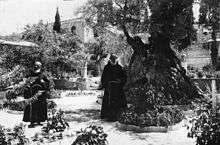Gethsemane
Coordinates: 31°46′46″N 35°14′25″E / 31.779402°N 35.240197°E

Gethsemane (Greek: Γεθσημανή, Gethsēmanē; Hebrew: גת שמנים, Gat-Šmânim; Syriac: ܓܕܣܡܢ, Gaḏ Šmānê, lit. "oil press") is a garden at the foot of the Mount of Olives in Jerusalem, most famous as the place where Jesus prayed and his disciples slept the night before Jesus' crucifixion.
Etymology
Gethsemane appears in the Greek of the Gospel of Matthew[1] and the Gospel of Mark[2] as Γεθσημανή (Gethsēmanē). The name is derived from the Aramaic ܓܕܣܡܢ (Gaḏ-Šmānê), meaning "oil press".[3] Matthew (26:36) and Mark (14:32) call it χωρἰον (18:1), a place or estate. The Gospel of John says Jesus entered a garden (κῆπος) with his disciples.[4]
Location

According to the New Testament it was a place that Jesus and his disciples customarily visited, which allowed Judas to find him on the night of his arrest.[5]
There are four[6] locations claimed to be the place where Jesus prayed on the night he was betrayed.
- The Church of All Nations overlooking a garden with the "Rock of the Agony."
- The location near the Tomb of the Virgin to the north.
- The Greek Orthodox location to the east.
- The Russian Orthodox orchard, next to the Church of Maria Magdalene by an orchard.
Dr. William M. Thomson, author of The Land and the Book, first published in 1880, wrote: "When I first came to Jerusalem, and for many years afterward, this plot of ground was open to all whenever they chose to come and meditate beneath its very old olive trees. The Latins, however, have within the last few years succeeded in gaining sole possession, and have built a high wall around it. The Greeks have invented another site a little to the north of it. My own impression is that both are wrong. The position is too near the city, and so close to what must have always been the great thoroughfare eastward, that our Lord would scarcely have selected it for retirement on that dangerous and dismal night. I am inclined to place the garden in the secluded vale several hundred yards to the north-east of the present Gethsemane."[7]
All of the foregoing is based on long-held tradition and the conflating of the synoptic accounts of Mark (14:31) and Matthew (26:36) with the Johannine account (John 18:1). Mark and Matthew record that Jesus went to "a place called the oil press (Gethsemane)" and John states he went to a garden near the Kidron Valley. Modern scholarship acknowledges that the location of Gethsemane is unknown.[8]
Pilgrimage site

According to Luke 22:43–44, Jesus' anguish on the Mount of Olives (Luke does not mention Gethsemane; Luke 22:39-40) was so deep that "his sweat was as it were great drops of blood falling down to the ground." According to the Eastern Orthodox Church tradition, Gethsemane is the garden where the Virgin Mary was buried and was assumed into heaven after her dormition on Mount Zion. The Garden of Gethsemane became a focal site for early Christian pilgrims. It was visited in 333 by the anonymous "Pilgrim of Bordeaux", whose Itinerarium Burdigalense is the earliest description left by a Christian traveler in the Holy Land. In his Onomasticon, Eusebius of Caesarea notes the site of Gethsemane located "at the foot of the Mount of Olives", and he adds that "the faithful were accustomed to go there to pray". Eight ancient olive trees growing in the Latin site of the garden may be 900 years old.[9]
Olive trees
A study conducted by the National Research Council of Italy in 2012 found that several olive trees in the garden are amongst the oldest known to science.[10] Dates of 1092, 1166 and 1198 AD were obtained by carbon dating older parts of the trunks of three trees.[10] DNA tests show that the trees were originally planted from the same parent plant.[10]
See also
| Wikimedia Commons has media related to Gethsemane. |
References
- ↑ Matthew 26:36 (King James Version); "Holy Bible: Greek New Testament (Scrivener 1894)". Christian Classics Ethereal Library. Retrieved 2009-03-25.
- ↑ Mark 14:32 (KJV); "Holy Bible: Greek New Testament (Scrivener 1894)". Christian Classics Ethereal Library. Retrieved 2009-03-25.
- ↑ Metzger, Bruce M.; Coogan, Michael D., eds. (1993). The Oxford Companion to the Bible. Oxford, UK: Oxford University Press. p. 253. ISBN 0-19-504645-5.
- ↑ John 18:1 (KJV)
- ↑ Brown, S. Kent (1992), "Gethsemane", in Ludlow, Daniel H, Encyclopedia of Mormonism, New York: Macmillan Publishing, pp. 542–543, ISBN 0-02-879602-0, OCLC 24502140
- ↑ Wycliffe Bible Encyclopedia, "Gethsemane", p.675, 1975, ISBN 0-8024-9697-0
- ↑ Easton's Bible Dictionary, Gethsemane
- ↑ The Complete Gospels: Annotated Scholars Version. 1994 by Polebridge Press. p. 108, note on Mt. 26:36
- ↑ Paul Maier In the Fullness of Time
- 1 2 3 Reuters (October 20, 2012). "Jerusalem olive trees among oldest in world". Haaretz.
- Taylor, Joan E., "The Garden of Gethsemane," Biblical Archaeology Review 21/4 (July/August 1995) 26-35: www.bib-arch.org/online-exclusives/Easter-03.asp
External links
- Catholic Encyclopedia on Gethsemane
- Paul’s Knowledge of the Garden of Gethsemane Narrative, by Christopher Price
- FotoTagger Annotated Galleries - Gethsemane in the art and reality
- Article on the history of the Russian monastery itself
| |||||||||||||||||||||
|
